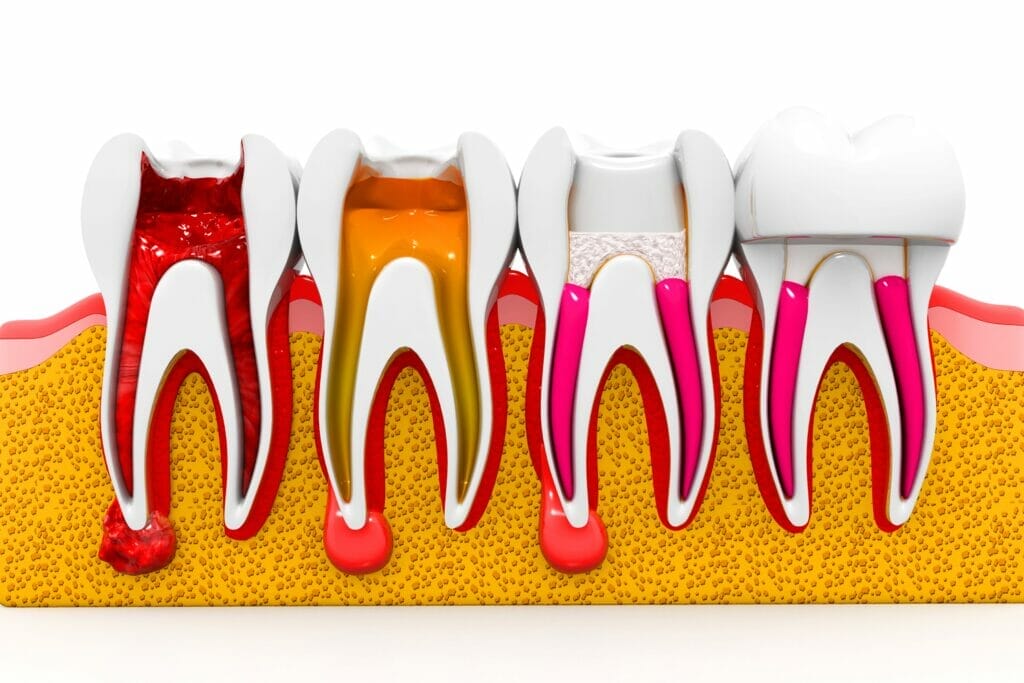
Root canal treatment is widely misunderstood. Pop-culture has contributed to this by portraying root canal treatment as an extremely painful procedure. In addition, the procedure and its indications are not typically well understood by patients. Patients deserve a sound understanding with respect to why they need treatment. They should also understand benefits associated with root canal treatment.
Let's start by explaining the procedure...
The image at the top of the page will give you a basic understanding as to what is done during the procedure. Here is the picture again including treatment steps:


In most cases, a root canal treatment does not hurt. Luckily, anesthetic methods have improved dramatically in the past 20 years. The vast majority of treatments are now painless. Rarely, a severe abscess will prevent complete anesthetic action. In these cases, a patient may feel intermittent pain or sensitivity during treatment. Referral of the patient may enable completion of treatment with sedation.
Commonly, in fact, treatment is necessary to eliminate an abscess or infection causing pain. Patients will commonly note that treatment provides pain relief.
Treatment costs are set out in the Ontario Dental Association (ODA) Fee Guide. Costs vary according to the specific tooth and how many root canals are present within it. Molars have 3 or 4 canals, Premolars have either 1 or 2 canals, and Canines and Incisor teeth 1 canal. Approximate costs are as follows:
Some Family Dentists provide all aspects of root canal treatment while others refer their patients to Endodontists (Specialists). Specialist fees for treatment are higher.
Yes. In most cases, treatment takes a single appointment. For teeth with 1-2 roots (front teeth, canines and premolars) the treatment time will be about an hour. For molars, treatment time may be 90-120 minutes as they often have 3-4 roots in total.
Occasionally, a Dentist or Endodontist (root canal treatment specialist) will perform treatment across 2 separate visits. This is often done when there is a large abscess or infection to enable observation. Splitting visits up allows the Dentist to see if the abscess is healing prior to finishing treatment.
When a newly-erupted tooth (in a child or teenager) needs root canal treatment, the immature roots may need time to finish developing before treatment can be completed. Sometimes these treatments will take place over a few appointments across 6-18 months. The Dentist will typically place a special medicine inside the nerve space or canal to speed up root development. Once the root matures, your Dentist can finish treatment.
If you would like to read more about Root Canal Treatment, please feel free to explore the American Academy of Endodontists literature on treatment, here.
Dr. Kyle Hornby provides simple and complex root canal treatment. If you would like to discuss treatment or obtain a second opinion, please request a consult here.
This article is intended to promote understanding of and knowledge about general oral health topics. It is not intended to be a substitute for professional advice, diagnosis or treatment. Always seek the advice of your Kitchener Dentist or other qualified healthcare provider with any questions you may have regarding a dental condition or treatment.
Services
Routine Dentistry & Tooth Repair
Oral Surgery & Tooth Removal
Prosthetic Dentistry & Tooth Replacement
Protective/Preventive Services
Teeth Whitening
Schedule an Appointment Now
